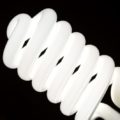New material could make LED light bulbs cheaper and easier to make.
Pervoskite is a material used to make solar cells as they are efficient at converting light to electricity. Now, researchers from the University of Oxford and the Ludwig-maximillions-Universtät in Munich have demonstrated a new application for perovskite materials, using them to make high brightness LED light bulbs.
The perovskites that were used to make the LED light bulbs were organometal halide perovskites, and contain a mixture of lead, carbon-based ions and holgen ions known as halides. These materials dissolve well in common solvents, and assemble to form perovskite crystals when dried they also require no heat or vacuum which makes them cheap and easy to make.
The first commercially available LED based perovskite could be available within 5 years.
One of the researchers at Cambridge University, Zhi-Kuang Tan, said:
It’s remarkable that this material can be easily turned to emit light in a variety of colours, which makes it extremely useful for colour displays, lighting and optical communication applications. This technology could provide a lot of value to the ever growing flat-panel display industry.




